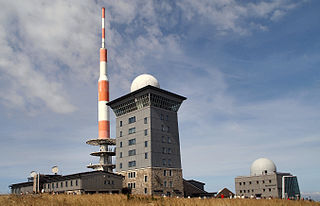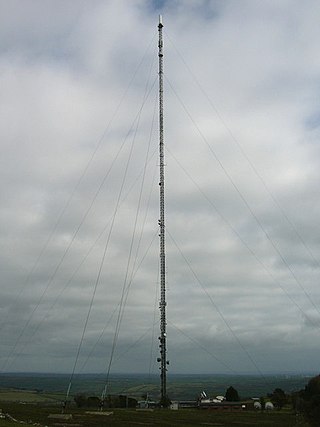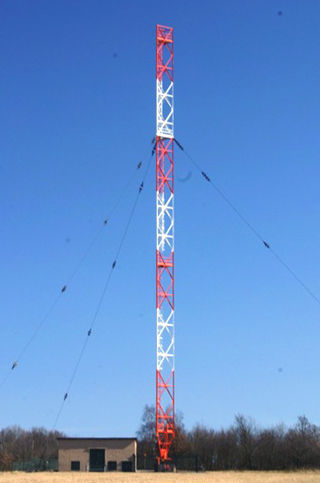The Sutton Coldfield transmitting station is a broadcasting and telecommunications facility located in Sutton Coldfield, Birmingham, England. In terms of population covered, it is the third most important transmitter in the UK, after Crystal Palace in London and Winter Hill near Bolton.

The Langenberg transmission tower is a broadcasting station that transmits MW, FM and TV signals. It is located in Langenberg, Velbert, Germany and has had a very turbulent history since its inauguration. The transmitter first went into service in 1927 with 60 kilowatts (kW) of power and a T-aerial hanging on two 100-metre freestanding steel-frame towers insulated against ground.

The Rheinsender is a large medium-wave transmission facility near Wolfsheim, southwest of Mainz for the frequency 1017 kHz. The Rhine transmitter was established in 1950 and went on the air May 15, 1950. It belongs to SWR and transmitted until the middle of the 1990s with 600 kilowatts. In the last years the transmission power was reduced to 100 kilowatts.

The Brocken Transmitter is a facility for FM- and TV-transmitters on the Brocken, the highest mountain in Northern Germany.

The Mendip transmitting station is a broadcasting and telecommunications facility on the summit of Pen Hill, part of the Mendip Hills range in Somerset, England, at 305 metres (1,001 ft) above sea level. The station is in St Cuthbert Out civil parish, approximately 2 miles (3.2 km) north-east of Wells. Its mast, 293 m (961 ft) high, was built in 1967 and is the tallest structure in South West England. The mast broadcasts digital television, FM analogue radio and DAB digital radio, and had broadcast analogue colour television from 1967 until 2010.

The Pontop Pike transmitting station is a facility for telecommunications and broadcasting situated on a 312-metre (1,024-ft) high hill of the same name between Stanley and Consett, County Durham, near the village of Dipton, England. The mast is 149 metres (489 ft) high, giving an average antenna height of 461 metres (1,512 ft) above sea level. It is owned and operated by Arqiva.
A broadcast transmitter is an electronic device which radiates radio waves modulated with information content intended to be received by the general public. Examples are a radio broadcasting transmitter which transmits audio (sound) to broadcast radio receivers (radios) owned by the public, or a television transmitter, which transmits moving images (video) to television receivers (televisions). The term often includes the antenna which radiates the radio waves, and the building and facilities associated with the transmitter. A broadcasting station consists of a broadcast transmitter along with the production studio which originates the broadcasts. Broadcast transmitters must be licensed by governments, and are restricted to specific frequencies and power levels. Each transmitter is assigned a unique identifier consisting of a string of letters and numbers called a callsign, which must be used in all broadcasts.

The Wrotham transmitting station is located on the North Downs, close to the village of Wrotham in Kent, England and just north of the M20 motorway. Its National Grid Reference is TQ595604. The current mast on the site was constructed in 1981, is 176.6 metres (579 ft) tall, and was built to replace the original mast of equal height that was constructed in 1951.
Transmitter Koszęcin is a facility for mediumwave and FM broadcasting near Koszecin, Poland. It was opened in 1977. It has two guyed masts: the first one is 110 metres high, is grounded, and carries antennas for FM broadcasting ; the second is 138m high. That second mast is insulated from ground and used for mediumwave transmission; broadcasting of the Radio Pahonia in Belarusian is planned on 1080 kHz with ERP 350 kW using this mast. The signal will cover the whole of Europe including the Ural Mountains. Earlier, the AM Mast was used for Polish Radio and used two Tesla transmitters 750 kW each in parallel. With the transmitted power of 1500 kW it was one of the most powerful mediumwave transmitters in the world.

The Rowridge transmitting station is a facility for FM radio and television transmission at Rowridge on the Isle of Wight in southern England.

The Wenvoe transmitting station, officially known as Arqiva Wenvoe, is the main facility for broadcasting and telecommunications for South Wales and the West Country. It is situated close to the village of Wenvoe in the Vale of Glamorgan, Wales, in the UK.

The Preseli transmitting station is a broadcasting and telecommunications facility on the eastern end of the Preseli Mountains, close to the villages of Crymych and Pentre Galar in Pembrokeshire, Wales. It is owned and operated by Arqiva.
The Oxford transmitting station is a broadcasting and telecommunications facility, situated on land 129.5 metres (425 ft) above Ordnance Datum to the north east of the city of Oxford, in Oxfordshire, England. It has a guyed steel lattice mast which is 154.4 metres (507 ft) in height to the top of the main steel structure. The UHF television antenna, which consist of a vertical array of transmitting panels, is mounted above the steel structure. The total height of the mast to the top of this UHF antenna is 165.7 metres (544 ft). It is owned and operated by Arqiva.

The Beidweiler longwave transmitter is a high-power broadcasting transmission site owned by RTL Group and operated by RTL company Broadcasting Center Europe. It was used to transmit the French-speaking programme of RTL on longwave frequency 234kHz until 1 January 2023. Based in Beidweiler, Luxembourg, the transmission site is situated at 49°43'58" N and 6°19'08" E and went into service in 1972 as replacement of the old Junglinster Longwave Transmitter. Junglinster remained in use as a backup site and for additional broadcast services.

Marnach transmitter was a broadcasting facility of RTL near Marnach in the commune of Clervaux, in northern Luxembourg. The Marnach transmitter was built in 1955 for improving the transmission of the English-speaking program on 1439 kHz, which was transmitted from 1951 with an omnidirectional antenna from Junglinster, to the British Isles and for a better transmission on this frequency to Germany at daytime. Therefore, it was given a directional antenna with a switchable directional characteristic pointing North-northeast towards the Rhine-Ruhr area, Germany's most populated area, and West-northwest in the direction of the UK. This antenna was implemented in form of a directional antenna consisting of three ground-fed 105-metre (350') tall guyed mast antennas arranged in the form of an isosceles triangle with a 90 degree angle. As transmitters, two 100 kW units switched in parallel were used when it went in service in December 1955.
Venets Transmitter is a facility for FM and TV-broadcasting near Venets and Samuil in Shumen Province, Bulgaria. Venets Transmitter uses as antenna tower a 302 metre tall guyed lattice steel mast with rectangular cross section. This mast, which was built in 1975, is the tallest radio mast in Bulgaria. The TV transmitter, which used it as antenna, was the most powerful TV transmitter in Bulgaria with 50 kW. It broadcast the program of BNT 1 on channel 5 and could be received in Romania, Moldova and Ukraine. In 2008 due to interference with foreign FM radio stations the transmitter was shut down and broadcasting of BNT 1 was switched to channel 56 on a new NEC transmitter. The analogue transmitters were shut down on September 30, 2015, when simulcast period ended and Bulgaria switched to DVB-T.

The St Hilary transmitting station is a facility for telecommunications situated close to the village of St Hilary, Glamorgan in the Vale of Glamorgan, Wales, in the UK. It comprises a 229-metre (750 ft) guyed mast with antennas attached at various heights. The site was established in 1958 for Independent Television transmission on VHF. Transmissions from the site include FM radio, DAB radio and mobile telephone signals.

The Blaenplwyf transmitting station is a broadcasting and telecommunications facility located near the village of Blaenplwyf about 10 kilometres (6 mi) to the south west of the town of Aberystwyth, in Ceredigion, Wales. It was originally built by the BBC, entering service in October 1956 acting as a main transmitter for BBC Band II VHF FM radio.
During World War II, the German Army relied on an diverse array of communications to maintain contact with its mobile forces and in particular with its armoured forces. Most of this equipment received the generic prefix FuG for Funkgerät, meaning "radio device". Occasionally the shorted Fu designation were used and there were exceptions to both these systems. Number ranges were not unique across the services so sometimes different equipment used by different services had the same FuG prefix. This article is a list and a description of the radio equipment.
Berlin-Köpenick transmitter was a transmission facility for broadcasting on medium wave, short wave, and VHF in Berlin-Köpenick, Germany, near the suburb of Uhlenhorst, after which it was occasionally named.













